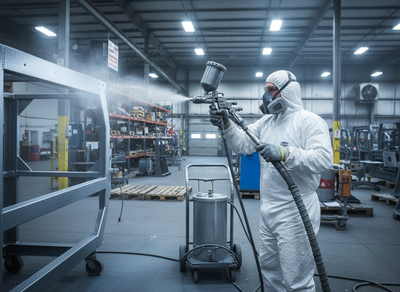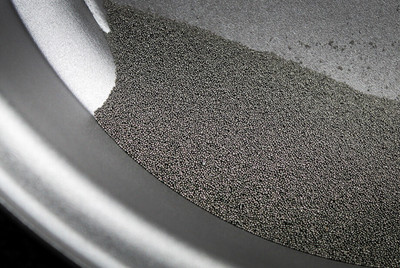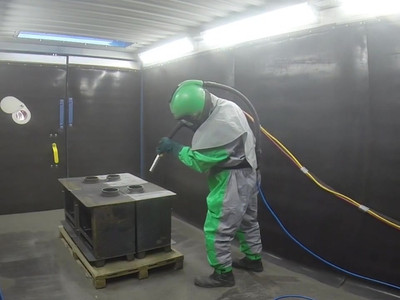24th Oct 2025
Moisture is a hidden enemy in abrasive blasting. Whether it’s from the environment, your compressed air line, or the abrasives themselves, too much moisture can seriously compromise your results. Understanding how moisture gets into the blasting process – and how to control it – is essential if you want consistent surface preparation and high-quality finishes.
In this blog, we’ll explore the different sources of moisture in abrasive blasting, the problems it can cause, and the practical steps you can take to prevent them.
Why moisture matters in abrasive blasting
Blasting relies on dry, clean abrasives being propelled at high speed to remove contaminants and profile a surface. When moisture enters the equation, it changes everything. It can cause abrasive materials to clump, reduce efficiency, create uneven surfaces, and even promote rusting on freshly blasted substrates.
Excess moisture also contributes to equipment breakdown, delays, and coating failures. Wet conditions inside blasting equipment can cause media blockages and inconsistent flow, leading to excessive downtime and rework.
Here are the three main ways moisture enters the blasting process – and why each one matters.
Ambient humidity
Airborne humidity can become a real issue, especially in warm or coastal climates. High relative humidity means the air already holds more water vapour, which increases the chances of condensation forming inside your blasting equipment or on surfaces before or after blasting.
Common wet blasting problems caused by ambient humidity:
- Flash rusting shortly after surface prep
- Poor adhesion of coatings
- Damp surfaces interfering with blast quality
Even indirect exposure to moisture – such as condensation caused by humid air – can affect surface cleanliness, particularly when surfaces are near or below the dew point.
Tip: Monitor weather conditions, especially dew point vs. surface temperature, and avoid blasting when conditions are too humid.
For sensitive or high-spec projects, use a dehumidification system or climate-controlled enclosure to maintain optimal blasting conditions.
Damp abrasives
Even abrasives stored in bags can absorb moisture from the air if not stored properly. When damp abrasives are fed through your blast pot, they can clog equipment, reduce pressure, and create inconsistent media flow.
Signs of blasting with damp abrasives:
- Inconsistent abrasive flow
- Frequent blockages or pressure drops
- Clumped or compacted media inside the hopper
Media that’s been exposed to ambient humidity or stored in poor conditions can create ‘bridging’ within the hopper, causing serious flow issues mid-blast.
Tip: Store abrasive media indoors in dry, ventilated conditions. Use sealed containers when possible and avoid leaving open bags in humid areas.
Moisture in compressed air
This is one of the most overlooked sources of trouble. Compressed air systems naturally generate condensation, and if the moisture isn’t properly filtered out, it will be carried directly to the blast nozzle – often with damaging effects.
Problems caused by compressed air moisture:
- Wet abrasive mixes at the nozzle
- Media clogging mid-blast
- Lower blasting efficiency and poor surface finish
In fact, even small quantities of moisture in compressed air can lead to serious inconsistencies in surface profile and adhesion, particularly when blasting steel or preparing surfaces for coating.
Tip: Always install moisture separators and air dryers as part of your setup. Regularly inspect and drain compressors and receiver tanks to keep systems dry.
Moisture control is critical not just for productivity, but for protecting the substrate from flash rust and ensuring long-term coating performance.
Practical steps to reduce moisture in abrasive blasting
Maintaining moisture control in blasting doesn’t have to be complicated – but it does require a consistent routine and some key investments.
Here are a few ways to keep operations running smoothly:
- Use inline air dryers and moisture traps: These should be standard in any setup to prevent water from entering your blast hose. Moisture removal units play a vital role in ensuring consistent media flow and clean, dry air delivery.
- Drain your air compressor daily: Don’t rely solely on automatic drains – manually check for water build-up, especially during long shifts.
- Store abrasives in dry, protected spaces: Use pallets, sealed bins, and desiccants if necessary to maintain dryness and prevent media clumping.
- Avoid blasting in high humidity when possible: Plan around weather conditions or invest in dehumidifiers or climate-controlled environments for critical jobs. Viva-Techs advises that even minor investment in climate control can significantly reduce costly rework.
- Inspect your setup regularly: Check for signs of rust, media clumping, or uneven blasting, and take corrective action quickly.
Whether it’s from humidity, damp abrasives, or wet air lines, moisture in abrasive blasting is a serious threat to performance. But with the right tools, storage methods, and daily checks, you can minimise its impact and maintain the quality of your surface preparation.
Need help improving moisture control in your blast setup?
Contact us for expert advice on air drying systems, storage solutions, and equipment setup.




